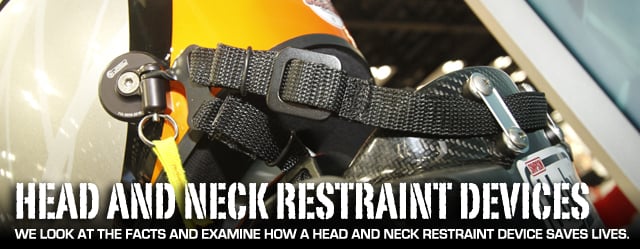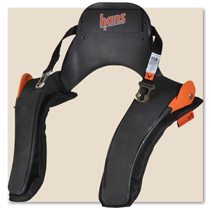Ever since the 2001 Daytona 500, when we witnessed the tragic death of legendary Dale Earnhardt, Sr. from a basilar skull fracture, head and neck restraint (HNR) systems have been commonplace in racing. Sure they were around before, but the loss of one of NASCAR’s all-time greats forced many sanctioning bodies to mandate the HANS (Head and Neck Support) device rule.
A short track driver can quickly go from 90 mph to 48 mph in a split second if he’s turned into the wall, enough to cause a fatal head and neck injury. – Jim Downing, President of HANS Performance Products
In the dozen years since that horrific February, we have seen many new safety innovations within motorsports. We’ve seen drivers survive crashes that would have easily killed them, 15 to 20 years ago. Full containment seats are now the norm. Today, the majority of drivers won’t step inside any race car without an HNR device. Many believe driver fatalities are on the decline, as a result. However, a study by the Charlotte Observer might surprise a lot of readers, and race fans.
While driver injuries and fatalities are on the decline within the top three NASCAR series, the Charlotte Observer released a study that took a look at accident related deaths within motorsports during the 10 years prior to Dale Earnhardt’s death, and the 10 years following. What they claim to have found is a surprising increase in deaths after Earnhardt’s death. The study not only measured circle track, but also drag racing. The results showed that 211 drivers died in the 10 years before that tragic day at Daytona. Yet unexpectedly, this number grew to 235 driver deaths in the same time period following.
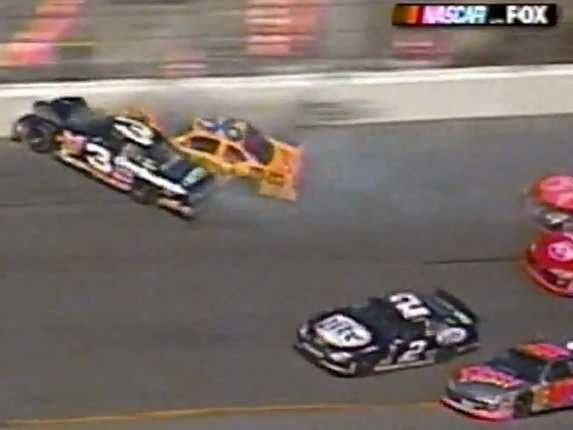
Many look at Dale Earnhardt Sr.’s death as the awakening of the safety age, but a study by the Charlotte Observer has pointed to the fact that since Sr.’s death there actually has been more driver deaths in motorsports.
So where is the discrepancy with this study? Many have called the death of Earnhardt Sr. – the awakening of the safety age – within motorsports. Drivers across the nation started to realize that if something this tragic could happen to Earnhardt, then it could happen to anyone. With new safety measures in place, the real question is why haven’t we seen a dramatic decrease in motorsports fatalities?
Expanding on the Charlotte Observer’s study, we turned to Jim Downing, President of HANS Performance Products, which were recently acquired by safety leader Simpson Performance Products. Downing shed some light on the increase in fatalities, “This increase in fatalities escapes many people involved in motor racing, because they mistakenly believe all the safety improvements from the major series have trickled down to the sportsman competitors who race on weekends. That is not the case.”
In 2001, NASCAR required the use of HANS devices in all of its touring series. Since that time, they have not had a single death behind the wheel. If you consider some of the accidents we’ve seen over the past 10 years, this is a very impressive feat! However, many short tracks and drag strips still do not require an HNR device in order to drive on their track.
42 MPH Is All It Takes To Kill You
Downing explained that a lot can be learned from studying Dale Earnhardt’s death, “In its detailed two-volume study of Dale Earnhardt’s fatal crash at Daytona, NASCAR consultants determined his car hit the wall at 160 mph and was suddenly slowed by 42 -44 mph in just 80 milliseconds. The 42-44 mph difference from when he first hit the wall and the ensuing sudden deceleration is known as the Delta V.”
Downing then related that 42 mph decline to drivers at the local short track and drag racing levels. “A short track driver can quickly go from 90 mph to 48 mph in a split second if he’s turned into the wall, causing a Delta V of 42 mph and enough to cause a fatal head and neck injury. If a drag racer hits the wall and drops from 120 mph to 78 mph in a split second, that’s enough to cause a fatal head and neck injury; again, a Delta V of 42 mph.”
Based on the information they gathered from Earnhardt’s death, it’s a wonder we didn’t see more deaths in the years prior to the HANS era. The research from Downing proves that it isn’t necessarily the speed you are carrying that you should be concerned with, but rather protecting yourself from the sudden stop.
Notice the difference between a driver using an HNR, and a driver without during a Delta V collision
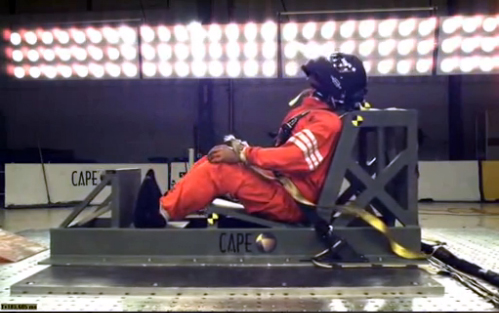
In December 2012, Downing worked with the Center for Advanced Product Evaluation (CAPE), based out of Indianapolis, to determine how much safer it really is for drivers to wear a head and neck restraint device. Through numerous crash tests they determined that without an HANS device, the head and neck will experience 40-gs of acceleration, resulting in 5800 newtons (N), or derived units of force in neck tension. These test results exceeded the standard for a fatal accident by45%.
When the same tests were conducted after attaching the HANS device to the same crash dummy’s helmet, CAPE found that the neck tension was reduced by over 90%.
Downing summed it up best after all the testing by saying, “No matter which class of car is involved, speeds on small ovals and drag strips are sufficient to generate a sudden stop that can be fatal. A significant number of lives can be saved with the universal use of certified head and neck restraints.”
When the first HNR device made its way on the race circuit, drivers complained about not having the range of motion, or side views that they had before using them. Since becoming compulsory for many race car drivers in 2001, the early design has undergone many new developments. And, many new manufacturers have developed HNR and HANS devices to correct the movement and visibility problems, while providing drivers with critical life-saving technology.
The HANS Improvements
The first HANS device was developed and patented by Dr. Robert Hubbard (HANS Performance Products) in the early 1980s, and included a tether system that driver’s felt limited the visibility of their side viewpoints. The device had a left and right side tether that attached the HNR device directly to both sides of the helmet. Drivers, especially in the dirt markets, were quick to complain that they couldn’t turn their head very far right like they were used to. This led a lot of drivers to disregard the HNR, letting them sit idle in their trailers unused. A scary thought when you consider that no dirt track in America has safe barriers. Some tracks still use tractor tires that have been concreted into the ground.
What companies like HANS Performance Products eventually did to solve this problem was use a solid tether, connecting both sides of the helmet to the HNR device with one tether that floats. Now when the driver turns his head to the right, the tether will shorten on the right and lengthen on the left, without compromising his safety.
Since acquiring the HANS line, Simpson Performance Products has debuted three new styles of HANS devices to accommodate even the pickiest of drivers. Simpson introduced a new design that allows the angle of the restraint to be adjusted to one of six different positions, adjusting to the seat angle changes between cars. “The adjustable HANS features five different adjustments in 5-degree increments. This is a range of 10 to 40 degrees to fit all cars and seat designs for the ultimate in driver comfort,” Debbie Bishop of Simpson Performance Products explained to us.
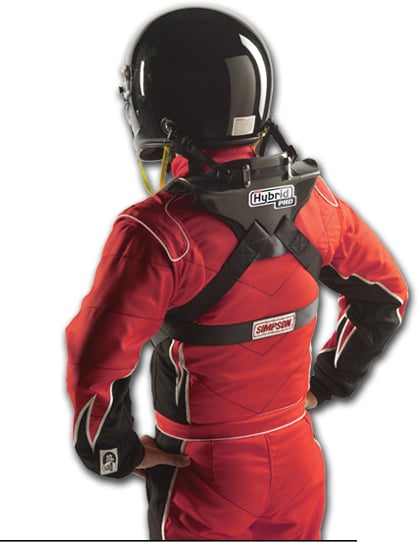
The Hybrid Pro HNR Device available by Simpson offers a low profile design for drivers to get in and out of their rides quickly.
The other big complaint drivers have had about HNR devices is the cost. A typical setup will cost you anywhere between $500 and $900. The folks at Necksgen now offer a certified SFI 38.1 HNR device in three sizes for $599. While Simpson’s HANS line starts at $645, the high-end HNRs are also more affordable now, at $795.
Simpson also offers drivers a hybrid line of HNR devices. The Hybrid line is an extremely low profile device that is SFI 38.1 certified, as well. Many dirt drivers that have extremely tight spaces to get in and out of their cars prefer this option to the standard HANS device design. Drivers like Scott Bloomquist, and Joey Saldana both utilize the Hybrid.
Conclusion
The fact that there still are fatalities and injuries within racing, speaks to how dangerous our beloved sport still is. The time is long gone to just assume that you, or your driver, are safe within the confines of the cockpit. Drivers aren’t invincible. Don’t let the greats in our sport, who tragically passed away doing what they loved, have done so in vain.
Ultimately, with all the innovations and advancements in the HNR line of products over the past three decades, there is just no good reason not to wear an HNR device, regardless of your race venue. Protect the ones you love, while they enjoy the sport they love.



